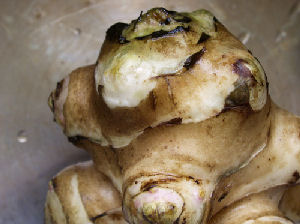Jerusalem Artichoke
 |
These knobby tuber vegetables are actually quite versatile in the kitchen. Enjoy them raw in salads or cook just like potatoes—bake, boil, steam, fry or mash. |
Contrary to what their name implies, Jerusalem artichokes are not artichokes. Nor are they from Jerusalem. These brown-skinned tubers are actually a variety of sunflower (Helianthus tuberosus) native to North America. Because of their confusing moniker, produce markets have taken to labeling them sunchokes. They are also sometimes referred to as sunroot, girasole, racine de tournesol and topinambour.
With a knobby appearance similar to gingerroot, sunchokes have light brown skins tinged with yellow, red or purple depending on the soil where they're grown. The inner white flesh is nutty, sweet, crunchy and comparable to jicama or water chestnuts. The versatile vegetable can be eaten raw in a salad, cooked into a side dish or incorporated into a wide variety of main courses.
History
Sir Walter Raleigh found Native Americans cultivating Jerusalem artichokes in what is now Virginia in 1585. In the early 1600s, Samuel de Champlain brought them to Europe, where they were known as "Canada" or "French" potatoes. In France, they are called topinambour, a term also used to describe an uneducated, uncouth person.
Varieties
Cultivated much more extensively in Europe than North American, Jerusalem artichokes are available in more than 200 varieties. Farmers are attempting to smooth out the bumps in newer breeds, so you'll find some are less knobby than others.
Buying Tips
Jerusalem artichokes are available year-round, but prime season is from October to March. Select those that are firm, clean and fresh-looking. Avoid any with soft, dark or moldy spots.
Storage Tips
Refrigerate in a plastic bag for up to one week. After that, they'll begin to lose moisture and wither.
Once cooked, refrigerate and use within two days.
Preparation Tips
Before eating or cooking, wash and scrub the tubers thoroughly with a vegetable brush. The skin is very thin and quite nutritious, so peeling is not necessary. If peeling is preferred, slice off the smaller bumpy areas with a knife, then use a vegetable peeler to remove the skin. If you will be eating them cooked, you'll find it much easier to boil, steam or microwave them whole and peel once done.
Cooking and Usage Tips
• Jerusalem artichokes can be cooked like potatoes—bake, boil, steam, fry or stew.
• Avoid using aluminum or iron pans—these metals will cause oxidation, turning the vegetable dark.
• Keep a close when cooking, as they easily turn to mush. Remove from heat as you can easily pierce them with a fork.
• Use instead of potatoes in potato pancake recipes.
• Employ mashed chokes as a thickener for soups and stews.
• Add to raw salads for sweet, crunchy texture.
• Dip sliced, raw pieces in acidulated water to keep the flesh from turning dark.





